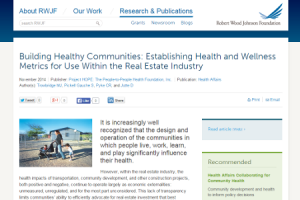 It is increasingly well recognized that the design and operation of the communities in which people live, work, learn, and play significantly influence their health. However, within the real estate industry, the health impacts of transportation, community development, and other construction projects, both positive and negative, continue to operate largely as economic externalities: unmeasured, unregulated, and for the most part unconsidered.
It is increasingly well recognized that the design and operation of the communities in which people live, work, learn, and play significantly influence their health. However, within the real estate industry, the health impacts of transportation, community development, and other construction projects, both positive and negative, continue to operate largely as economic externalities: unmeasured, unregulated, and for the most part unconsidered.
This lack of transparency limits communities’ ability to efficiently advocate for real estate investment that best promotes their health and well-being. It also limits market incentives for innovation within the real estate industry by making it more difficult for developers that successfully target health behaviors and outcomes in their projects to differentiate themselves competitively.
This article, co-authored by Network executive director Doug Jutte and colleagues from the University of Virginia and the US Green Building Council, appeared in the November 2014 issue of Health Affairs. The authors outline the need for actionable, community-relevant, practical, and valuable metrics jointly developed by the health care and real estate sectors to better evaluate and optimize the “performance” of real estate development projects from a population health perspective. Potential templates for implementation, including the successful introduction of sustainability metrics by the green building movement, and preliminary data from selected case-study projects are also discussed.